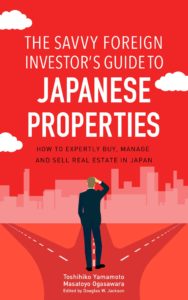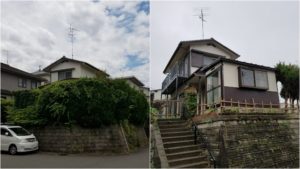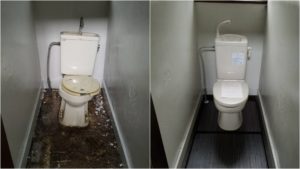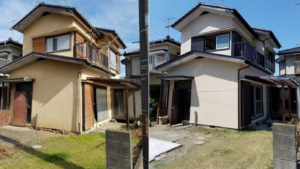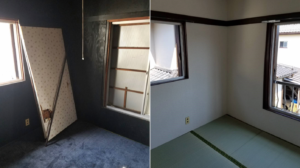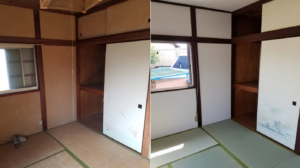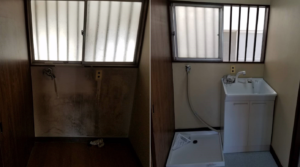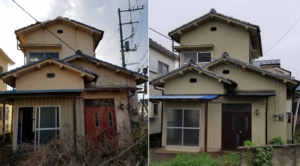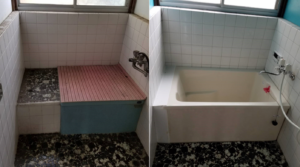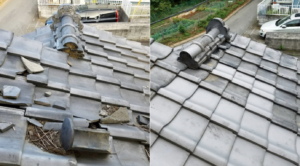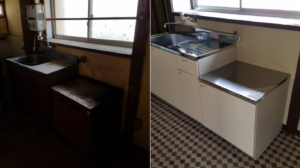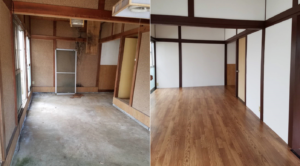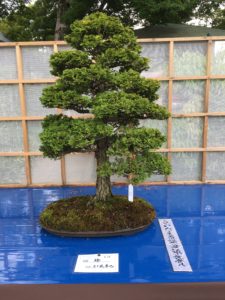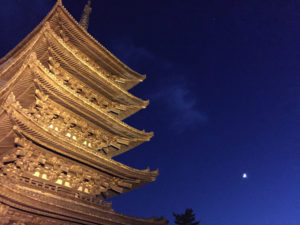(Flipped house in Chiba city, east of Tokyo. Before and After)
* Foreigners can buy a property in Japan without having special qualification.
Who can put a price on akiya (abandoned houses,空き家) in Japan ? You can.
There are more than 8 million distressed or abandoned houses in Japan.If you want to flip these akiya (abandoned house) into a rental property, there are quite a few opportunities out there. Akiya in Japan is a big social issue as akiya can generate serious security issues like fire, weeds, pests and burglars. Investing in akiya in a sense solves social these issues.You can find the possibilities of getting a great deal very quickly at relatively small risk exposure. But you have to find a right property in a right location.
Here is how it works
In real estate business, you probably make your money when you buy a property not when you sell it. If you don’t buy the property at the right price and/or terms, then there won’t be any good profit when you sell it.The same phrase can be applied to your home.Even if your initial plan was to live in a property (your home that is) for a long time, life is full of unexpected ventures and you may have to sell it in the future.The real estate is contained in the relatively low liquidity dimensions compared with other financial assets such as stocks, bonds and the transaction costs are high.Thus you want to be very careful when you buy a property.This is true for investors to flip a property.
Usually house flipping in the US is referred as a short-term strategy i.e. buying and renovating a house and sell it at higher value in the short term. A flipper usually needs to get out in less than six months.However, in Japan, it is not a very common style.Today I am illustrating a Japanese style house flipping; flipping akiya (abandoned house, 空き家)into a rental property.You don’t have to stick to akiya for flipping but they are naturally very affordable to come by.One of our business partners is actively investing in akiya (abandoned house).Here’s a simple strategy we usually recommend for flipping akiya into a rental property.
Location
We usually locate a property in suburban areas of Tokyo where you can find a decent one for flipping.
You should be able to find an appropriate property in Kansai (western Japan) areas but we don’t cover those areas simply because it is too far to visit the sites.
Areas we cover (but limited to suburbs and outskirts)
Kanagawa
Chiba
Saitama
Tochigi
Locations of recent deals:
-Chiba city, Wakaba ward in Chiba Pref.
千葉県千葉市若葉区多部田町
千葉都市モノレール2号線 千城台駅 徒歩48分
-Furukawa city in Ibaraki Pref.
茨城県古河市関戸
宇都宮線 古河駅 徒歩58分
-Kasukabe city in Saitama Pref.
埼玉県春日部市
東武伊勢崎線 せんげん台駅 徒歩14分
You don’t have to worry about the distance from the station in suburban areas as unlike people in big cities, residents
commute by car.
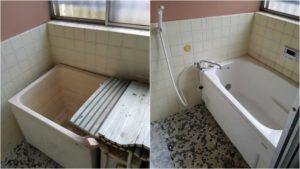
(Flipped house in Chiba city, east of Tokyo. Before and After)
Key strategy
The point of this type of house flipping to rent is the leveraging the market distortion.
On average, the value of the property in central Tokyo is about 20-30 times more than that of some suburban areas of Tokyo.However, the rent for the same property does not automatically calculate 20-30 times more in central Tokyo and usually is in the range of 5-6 times.
Given the condition of the property is in the reasonable state, even if the property is small in suburban areas, the landlords can always charge minimum rent.
In other words, the bottom of rent is always limited.
As an easy-to-understand example
Value
A property in central Tokyo 50 square meters : 60 million yen…(1)
A property in some suburban areas 50 square meters : 3 million yen… (2)
(value : 20 times)
Rent
Rent in the same area for 50 square meters property in Tokyo : 300,000 yen per month… (1)
Rent in the same suburban areas 50 square meters property : 50,000 yen per month… (2)
(rent: 6 times)
This is where you can leverage. A different style (different from the conventional investment) of real estate investing can be crafted out of the suburban locations each investors found themselves in.
And to be on a safe side, we usually target the very low end of rent in the region when we calculate the projection.
If your rent is already at the low end, your chances of losing a tenant are also low.You want to consistently outperform the competition.
Specifically, it is essential for you to find a property with decent condition in the right region which could generate 50,000-60,000 yen rent
(after the renovation work). Otherwise your math won’t work. The properties meeting our needs change hands quickly and it is vital for you to make a decision in a matter of days.
Here’s an example of a deal:
Price range
It varies but in many cases, total investment is between 5 million yen (U$50,000) to 7 million yen (U$70,000) including searching fee, land, house, renovation cost, transaction cost and *consulting fee
*If you can locate a property yourselves and flip it, obviously you are not required to pay the consulting fee.
Finance costs
Finance costs are usually high in the home-flipping business and banks are not willing to put up the mortgage loan.So majority of customers are using their cash to finance the deal.However, for the hypothesis math, let’s suppose that we can borrow the money from Japan Finance Corporation (日本政策金融公庫. And let’s suppose we manage to obtain financing the deal at 3% pa for 10 years term.
(Flipped house in Chiba city, east of Tokyo. Before and After)
Renovation expenses
From the beginning, we usually search for a property that would not require major renovation, but don’t underestimate them and get the estimate from the professional service.Most people are shocked when they hear how much a home remodel project will cost.To be on safe side, getting multiple bids is recommendable but not many construction companies are willing to give you bids in the rural area. And finding a reliable construction company is a key. Our business partners are pretty good at maintaining the cost within certain budget.I don’t recommend to do work yourself. Bad work is worse than no work at all, and finance costs can quickly eat up DIY savings.
Purchase price calculations
Hypothetical calculation based on the previous deal:
Purchase price : 3,000,000 yen (U$30,000)
Renovation cost :2,600,000 yen (U$26,000, including consulting fee)
Transaction cost : 277,000 yen (U$2,777)
Total initial investment 5,877,000 yen (U$58,770)
Rent : 60,000 yen (U$600) per month, 720,000 yen (U$7,200)per year
Gross yield (gross capitalization rate) : 12.25 % pa (720,000 divided by 5,877,000)
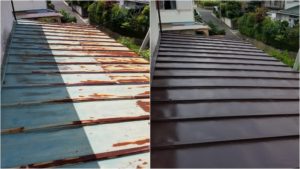
(Flipped house in Chiba city, east of Tokyo. Before and After)
Exiting strategy
If you maintain the property in good condition with an existing tenant, you should be able to sell it at par or a touch lower say in 5 years time.Let’s suppose you will sell your property slightly lower price at 14% yield (rather than 12% yield you originally bought for) in 5 years time.
The market value of your property would be around 51,000,000 yen (720,000 divided by 14%)
Plus, let’s suppose you have spent 500,000 yen for the maintenance cost in last 5 years.
You will have gained 3,600,000 yen through the rent in last 5 years. (100% occupancy, 60,000 yen x 12 months x 5 years)
If you can sell it at 14 % gross yield in 5 years time, overall you are well in surplus.
Your crude expected profit (100% occupancy basis, excluding tax and other factors) in 5 years would be around 2,323,000 yen
Not bad for the initial investment of 6 million yen ?
But in 5 years time, anything can happen and I have to say it is not easy to predict the market condition in 5 years.
For the worse scenario, let’s suppose you can sell only at 20% gross yield, your property would be valued 36,000,000 yen.
The rest of the projection is the same as 14% case and you are still in surplus (about 800,000 yen surplus) You should know from the very beginning there are always moving parts in this type of investment.
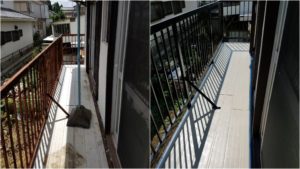
(Flipped house in Chiba city, east of Tokyo.Before and After)
Final thoughts
If you want to flip akiya (abandoned house) into a rental property, there are quite a few opportunities out there. You can find the possibilities of getting a great deal very quickly at relatively small risk exposure.
The key is selecting a right property in the right location in the right region where you can expect reasonable demand for a rental property; a region with reasonably concentrated population base. Don’t pick any distressed property. The drawback is finding a suitable property (and you must make a quick decision) in suburban areas and renovation work. It can be time consuming and cumbersome for the conventional investors.You also need to watch the early sign of risks for exiting.There are moving parts in this business.
How to calculate return on investment (ROI) on the real estate
Are you interested in akiya 空き家(abandoned house) for free in Tokyo ?
Our Consultation Service
Spot consultation is available for those who are interested in buying an old Japanese property.
Spot consultation fee starts from 50,000 yen per two hours (plus tax). Consultation over Internet telephone is possible for those who are distant from Tokyo.
If you are seriously interested in buying akiya, please contact us. Consultation fee starts from 50,000 yen per two hours (plus tax). We provide the following consulting service for akiya investment as well.
1) Akiya search service
100,000 yen (plus tax) per project. We will look for an appropriate akiya for you.
It requires time consuming process.
Finding a good akiya is not as easy as you might think.
If you buy a wrong property in a wrong location, your investment could be a disaster.
We will not search akiya for free.
If you are seriously interested in buying a Japanese old house, please contact us.
P.S.
Some other sample photos (all Before and After side by side)
1.Example A
2. Example B
If you are interested, please don’t hesitate to contact us.
************
(Japanese bonsai)
Toshihiko Yamamoto
Real estate investing consultant and author.
Founder of Yamamoto Property Advisory in Tokyo.
International property Investment consultant and licensed
real estate broker (Japan).
He serves the foreign companies and individuals to buy and sell
the real estates in Japan as well as own homes.
He holds a Bachelor’s degree in Economics from
Osaka Prefecture University in Japan
and an MBA from Bond University in Australia
Toshihiko’s book, “The Savvy Foreign Investor’s Guide to Japanese Properties: How to Expertly Buy,
Manage and Sell Real Estate in Japan”is now out on Amazon, iBooks (iTunes, Apple) and Google Play.
About the book
Amazon.com Link
